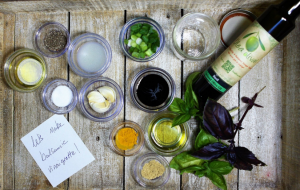The Art of Making a Perfect Vinaigrette
The Art of Making a Perfect Vinaigrette

Vinaigrettes are one of a foodie’s basic kitchen and cooking elements. Vinaigrette is one of the simplest marinades and sauces to make at home and offers an instant upgrade to any salad green or vegetable. Most of us have used bottled salad dressing at one time or another simply out of convenience, but the truth is there is no healthier way to dress your veggies (and fruits!) than a simple sauce made from extra virgin olive oil and quality balsamic vinegar. It’s quick to come together and keeps well, so you can use it throughout the week. Add to that the heart-healthy benefits of extra virgin olive oil and the elimination of something produced in a factory from your diet, and there is no excuse for not making your own vinaigrette.
Synergy
Because nutrients in food work synergistically, eating a combination of certain foods is often more beneficial than eating them alone, and such is the case with drizzling extra virgin olive oil over your salad. The olive oil boosts the absorption of eight micronutrients. They include four carotenoids: alpha-carotene, beta-carotene, lycopene, and lutein. The remaining three are vitamin K and two forms of vitamin E. We’ll start with a simple formula for making vinaigrette that can be modified in thousands of ways to create world-class combinations of flavor and texture. Once you master the basic technique, you can start experimenting with different ingredients Let’s begin!
Balance
First, know the ratio. A vinaigrette is typically made from 3:1 or 2:1 oil-to-vinegar ratio. If you’re using a standard wine vinegar or lemon juice, or one of Olea Oliva’s Lambrusco vinegar, this is a good ratio to use. If you are using a sweeter vinegar, like an aged balsamic or a fruity balsamic with more sweetness, you make want to use the ratio of 2:1 oil-to-vinegar ratio. The oil acts to balance out the acidity of the vinegar, so an acidic or tart vinegar will require more oil. A sweeter vinegar, like aged balsamic, has a more mellow acidity, requiring less oil for balance. You can also choose to experiment with a combination of citrus juices and vinegars.
Emulsion
Second, whisk (or blend) well. For a vinaigrette to literally come together, it has to be properly mixed into an emulsion. If the oil and vinegar aren’t emulsified, they will stay separate creating bites that are too oily and or too sharp. If the oil and vinegar are properly emulsified, the sauce will take on a thicker, creamier, more pleasing texture that will evenly coat your greens or vegetables.
How do you achieve that emulsion? All you need are a bowl and a whisk and a little patience. Start with the vinegar, some salt, and pepper (I usually start with a pinch of salt and pepper) in the bowl and add just a small amount of olive oil, whisking to incorporate. As the mixture begins to come together, continue to add the olive oil, in a slow steady stream, until the sauce is creamy and blended. You can also add a touch of Dijon mustard to your vinaigrette which will act to stabilize your emulsion without changing the flavor much.
Season
Third, taste and season. There are many ways to flavor a vinaigrette, but salt and pepper are the common ones. Once your emulsion comes together, taste and adjust the seasoning to your liking.
How much should you make? A quarter of a cup is generally enough for four servings of a leafy green salad. If you’re making a vegetable salad or like to go heavy on the dressing, make a half cup per four servings. If you’re dressing a potato salad, make extra as potatoes tend to soak up a lot of vinaigrette. You can always double the recipe and store the excess vinaigrette in an airtight container for up to a week.
As with all food, by making your own salad dressings, you are in control of the flavor balance—acidity, sweetness, and seasoning—as well as what goes into it, so you can avoid those unwanted things like unpronounceable preservatives, scary oils, thickeners, sugars, etc. Making your own salad dressings is one of the simple tips I offer for shifting from processed foods to homemade, whenever I do workshops and when I consult one-on-one with nutritional clients. It literally doesn’t get much easier than this. Here are some of my healthy recipe ideas.
Salad Dressing Suggestions
Anti-Inflammatory packed Healthy Vinaigrette:
- 2 tbsp Spanish Signature Blend Extra Virgin Olive Oil
- 1 tbsp Honey Serrano Chile vinegar
- ½ tsp Ginger Infused Honey (optional)
- 1 tsp fresh lemon or orange juice
- ¼ tsp of ground Turmeric
- ¼ tsp of ground Ginger
Avocado Spinach Dressing:
- ½ cup fresh packed spinach
- ½ ripe avocado (cut into chunks)
- 1 clove garlic, minced
- 1 scallion (cut into ½ inch slices)
- juice of 1 lemon
- ½ cup Chilean Frantoio Extra Virgin Olive Oil
- 1 tbsp Garlic Cilantro Balsamic Vinegar
- 2 tsp nonfat plain yogurt
- ½ tsp salt
- ¼ tsp pepper
Simple Vinaigrette:
- 2 tbsp freshly squeezed lemon juice
- 1 tsp lemon or orange zest, grated
- ½ tsp oregano
- 1 clove garlic, minced
- ½ tsp Dijon mustard, Optional
- ½ tsp salt
- ½ cup Meyer Lemon Olive Oil
- ¼ cup Honey Ginger Balsamic Vinegar
Cilantro Lemon Vinaigrette:
- ¼ cup Lemon Balsamic
- ½ cup Persian Lime olive oil
- 1 tbsp water
- 2 handfuls cilantro
- few sprigs of fresh mint
- 2 tbsp fresh lemon juice
- 1 small green chili, seeded and roughly chopped
- 1 clove garlic, roughly chopped
- ¼ tsp. salt
- 1 tsp honey
- SHARE THIS POST


